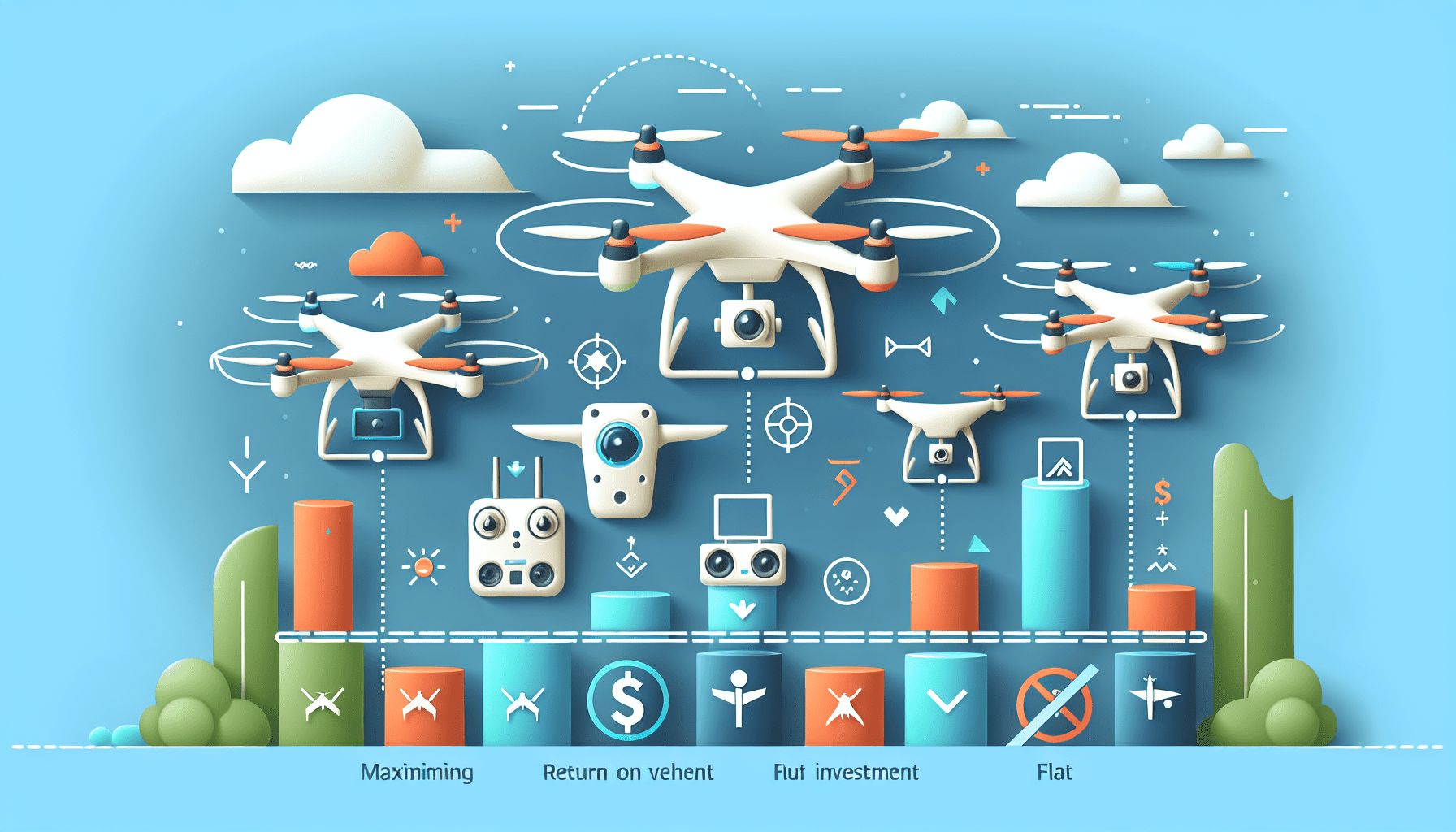ROI for Drone Purchases: Maximize Your Investment Wisely
In This Article
- Evaluate drone features specific to your industry to increase operational effectiveness.
- Invest in training and key accessories to avoid unnecessary losses and enhance output quality.
- Create a maintenance routine to extend operational drone life and performance.
- Use ROI formulas prior to purchase to forecast long-term savings or earnings.
- Start small with rentals or cheaper units; scale investment as benefits become clear.
The Importance of ROI When Buying a Drone
Understanding Financial and Practical Benefits
In today’s rapidly evolving technological landscape, understanding the ROI for Drone Purchases is no longer optional—it’s essential. Whether you’re a small business owner, a filmmaker, a surveyor, or part of an agricultural enterprise, drones are not just high-tech gadgets. They are tools that, when used effectively, can drive efficiency, reduce costs, and open up new revenue streams. Assessing the return on investment allows you to make smarter purchasing decisions, particularly when selecting between consumer and commercial-grade drones.
ROI, or return on investment, is a metric used to measure the profitability or benefit yielded from an investment relative to its cost. For drone buyers, this means understanding not only the upfront cost—including accessories, licensing, and training—but also the long-term gains. These might include time savings, expanded capabilities, reduced manpower expenses, and more accurate data collection. The key is to balance cost with expected benefits to ensure the drone pays for itself quickly and continues to add value.
More and more industries are discovering that drones can significantly elevate workflows. For example, agricultural businesses are using drones to survey crops and manage irrigation more precisely. Similarly, in real estate, drones offer high-resolution aerial video tours that increase property viewings. In both cases, the drone acts as a value multiplier—amplifying the outcome while minimising manual efforts. Evaluating ROI helps clarify which drone model, features, and accessories align best with your intended goals.

Choosing the Right Drone for Maximum Returns
Balancing Features With Cost
When it comes to maximising the ROI for Drone Purchases, choosing the right drone is absolutely critical. Many first-time buyers fall into the trap of either overspending on features they’ll never use or underspending and sacrificing performance. A thorough cost-benefit analysis is vital. Start with your primary use: Are you capturing aerial photography, inspecting assets, mapping terrain, or spraying crops? Each objective demands specific capabilities.
For aerial photography and videography, 4K camera resolution, stabilisation gimbals, and extended flight time are key. On the other hand, for thermal inspections or agricultural monitoring, drones with multispectral or thermal sensors yield greater accuracy and depth. While these special-purpose features may raise the upfront cost, they can result in enhanced operational efficiency, data quality and ultimately, a better return on investment.
Battery life, range, flight stability under wind, autonomous flight features, warranties, and brand support all factor into your ROI calculation. Remember, a drone with a slightly higher cost but superior durability and after-sales service may outperform a cheaper alternative that requires frequent repairs or replacements. Investing in features matched closely to your operational needs ensures more productive flight sessions and less downtime, which translates to greater financial returns.
“The operational cost savings we achieved after integrating drones into our asset inspection process paid for the purchase within four months.”
How Training and Accessories Boost ROI
Buying a drone is just the beginning. To optimise the ROI for Drone Purchases, consider the ecosystem of training and accessories that enhance usage, safety, and reliability. Too often, operators underestimate the importance of training. Poorly trained users are more likely to crash the drone, misuse its capabilities, or violate local airspace regulations. Investing in certified training courses results in more skillful piloting, higher-quality content, and fewer accidents.
Beyond training, strategic accessory investments can expand a drone’s functionality. Spare batteries are essential for extended sessions, ensuring crews don’t waste time waiting for recharges. ND filters improve visual output for photographers, while thermal sensors allow inspection professionals to identify issues with pinpoint accuracy. Even simple accessories like landing pads and carry cases contribute to longevity and performance.
When a drone operator is well-trained and equipped, project completion time shortens, quality improves, and inconsistencies reduce. These outcomes directly elevate value-per-flight. Not to mention, accessories and training are usually inexpensive compared to replacing a damaged drone. Incorporating these costs into your budget from the outset improves overall ROI by preventing avoidable losses and unlocking higher-value outputs.
Maintenance Tips That Keep ROI High
Routine maintenance is the cornerstone of protecting your drone investment. A well-maintained drone operates reliably and safely, extending its useful lifespan and reducing operating costs. To sustain a high ROI for Drone Purchases, create and follow a routine maintenance checklist that covers regular calibration, firmware updates, visual inspections, and battery health monitoring.
For instance, propeller damage, even minor, can compromise flight stability. Clean sensors and camera lenses ensure peak imaging performance. Also, batteries should be stored in climate-controlled environments and charged using recommended protocols to maintain capacity. Log all maintenance activities—this becomes especially useful for businesses managing multiple units and adhering to regulatory standards.
Regular software and firmware updates are also essential. Manufacturers often release performance improvements, flight enhancements, and security patches. Keeping software current ensures the drone operates at optimal efficiency, reducing the number of aborted flights due to software error or outdated mapping data.
Drone Features That Impact ROI the Most
Several drone features directly influence overall return on investment, and savvy buyers should evaluate these carefully before purchase. Top among them are flight time, camera quality, sensor compatibility, intelligent flight modes, and connectivity.
Flight Time: Longer battery life means fewer returns to base, less downtime, and more time collecting value-adding data.
Camera and Sensor Quality: High-resolution cameras and optional sensor integration such as thermal or LiDAR directly affect data quality. Poor data leads to repeat flights and adds inefficiency.
Intelligent Flight Systems: Drones with intelligent flight capabilities such as waypoints, object tracking, and follow-me modes offer consistent results with less manual intervention—particularly valuable in surveying, events, and inspections.
Modularity: A drone that supports interchangeable payloads can adapt to varied tasks, reducing the need for multiple purchases and thus increasing your ROI.
ROI for Drone Purchases in Small Businesses
For small businesses, especially those constrained by tight budgets, ensuring a high ROI for Drone Purchases is vital. Small enterprises in sectors such as construction, real estate, agriculture, and event photography can benefit immensely from drone adoption, but these benefits are only realised if the packages purchased align with operational goals.
For instance, a construction firm might use drones to create detailed progression reports, enhancing client transparency and reducing manual survey hours. A local photographer may use aerial shots to command higher rates for wedding packages. What’s common across these use cases is that drones enable small businesses to do more with less.
It’s also worth highlighting the opportunities for small businesses to rent drones initially, test ROI potential, and only then invest in ownership. For SMEs unsure of long-term drone use, this model offers an excellent ROI path with lowered entry risk. For further advice tailored to small companies, visit: Learn more about Drone Investment Strategies
Choosing Between Consumer vs. Commercial Drones
Whether to buy a consumer or commercial drone is a decision that should also hinge on ROI projections. Consumer drones are typically more affordable, user-friendly, and quicker to deploy. They’re suited to jobs that require quick footage, relatively low-resolution imaging, or hobbyist-level usage.
Conversely, commercial drones bring a wealth of advantages—larger payloads, extended range, superior imaging systems, and enterprise-level software integration. They also tend to offer better support, longer warranties, and regulatory advantages. While the initial outlay is higher, commercial drones tend to deliver better ROI for Drone Purchases in professional applications through scale, ruggedness, and precision.
Consider your application scope both now and 12 months from now. Scaling with a consumer drone might force early replacement, thus lowering ROI. For high-frequency, data-heavy uses, commercial-grade equipment pays off in less than a year. Review comparison breakdowns here: Read a related article
How to Calculate ROI Before Purchase
Understanding how to preemptively evaluate the ROI for Drone Purchases requires a structured cost and benefit forecast. Start by tallying upfront costs—this includes the drone, associated software, accessories, training, insurance, and any required certifications. Then, project your benefits: How much time and labour will be saved? What is the added value of aerial data or media? How quickly can the drone recover its investment through billable work or savings?
For example, a roofer might spend £500 on drone gear but save £300 per month by reducing ladder inspections. That would yield ROI in less than two months. Use basic financial formulas for ROI:
ROI (%) = (Net Return / Total Cost) x 100
Here’s a helpful online tool to simulate ROI scenarios: See how drones provide ROI in infrastructure and construction
Case Studies: ROI Success Stories
Agriculture: A farm in Yorkshire implemented drones for livestock tracking and crop scanning. With reduced fuel and manpower costs, they recovered the purchase price in just three months.
Inspection Services: A Scottish utility provider reduced site inspection time by 75% using thermal drones. This resulted in a net ROI of 220% within the first year.
Real Estate: A London-based agency using drones for listings saw a 30% increase in online engagement and a 12% faster closing rate, translating directly to additional commissions.
These success stories demonstrate how high levels of ROI are possible across varied sectors when appropriate drones and practices are implemented.
Final Thoughts: Smart Drone Buying Decisions
[CONCLUSION_CONTENT]
Great guide on maximizing-return-on-investment-when-buying-a-drone – Community Feedback
What does ROI mean when buying a drone?
ROI, or return on investment, refers to the financial or practical benefits you receive in relation to the cost of purchasing a drone. This includes cost savings, efficiency, and revenue generated.
How can I maximize my ROI when purchasing a drone?
To maximize ROI, carefully assess your needs, select a drone with suitable features, invest in training, and choose quality accessories. Efficient use and regular maintenance will also boost value.
Are drones a good investment for businesses?
Yes, drones often deliver substantial ROI for businesses by saving time, reducing manual labor, and improving data accuracy—especially in sectors like agriculture, inspection, and construction.
What features should I look for to boost drone ROI?
Look for features such as high-resolution cameras, long battery life, durable materials, and smart flight modes, as these contribute to better performance and longer service life.

